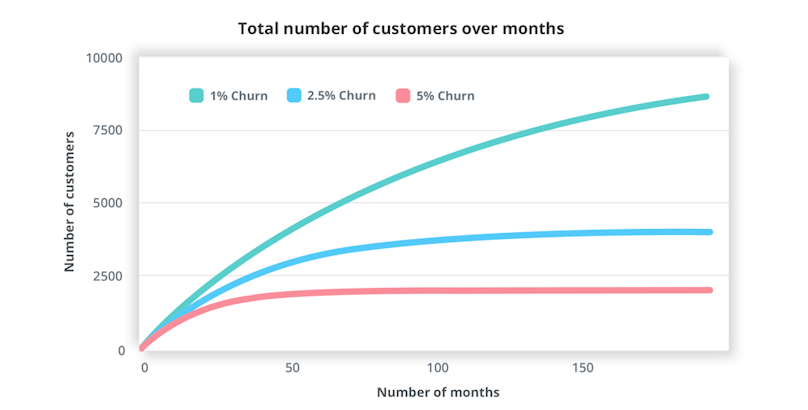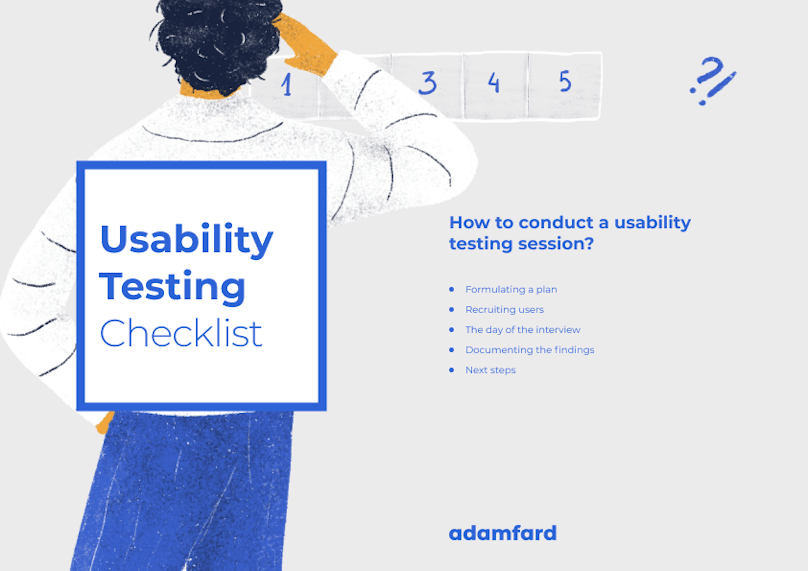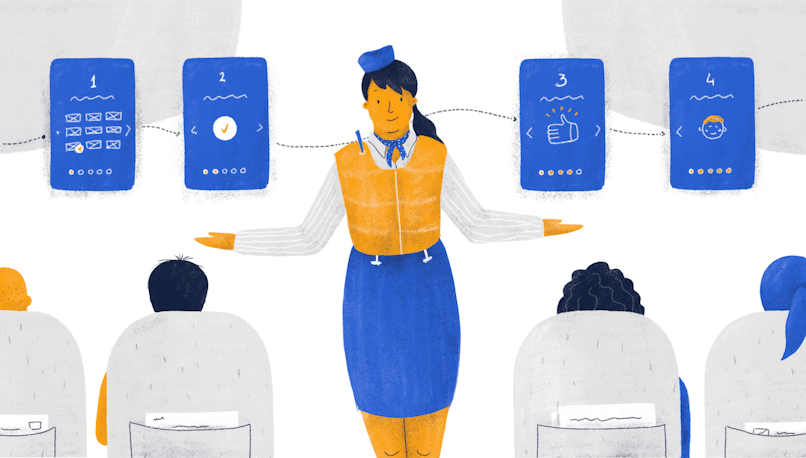Simply put, churn is the opposite of growth—it’s the total number of customers that a company loses within a specific timeframe. In most cases, you’ll see churn reflected as a percentage of the product’s entire customer base. This is a vital indicator of a product’s success since it provides us with an understanding of how many of the customers that have once used the product have left dissatisfied. Learning about the cause of this dissatisfaction is an important first step towards its mitigation.
This metric is especially important among SaaS products due to their subscription-based business model. Calculating and predicting churn rates allows SaaS products to estimate their revenue in the near future.
In this article, we’ll take a closer look at the ways churn affects SaaS products and how UX practices can help them diminish their churn values.
How churn affects your SaaS business, and why should you care?
Unless you want to run your business into the ground, keeping churn rates low is imperative. Of course, some churn will be inevitable—like customers with short-term needs or subscriptions made by mistake, but it’s a business’s goal to keep it as low as possible. It's absolutely mandatory to monitor this SaaS metric.
For example, let’s say you lose 5% of your clients on a monthly basis; over the course of one year, this will amount to ~46% churn. Losing 46 customers out of every 100 in a uniform set of users will result in a 46% in revenue churn. Of course, it’s a little more complex than that, because SaaS products often have different user tiers. However, the point is that churn makes your product lose money and impedes its growth.

Source / This graph shows how much influence churn has over the number of users.
How to calculate Churn for a SaaS app
As straightforward as it may appear, there’s a sheer amount of complexity to calculating churn, and the metric’s meaning can get a little blurry at times. For example, you can calculate the number of customers that have stopped using your services or the dollar amount lost as a result. Some businesses choose to look at net churn; others focus on gross churn. According to a report published by key.com, there are now about 40 different ways to calculate churn among SaaS products.
But we’ll keep things simple today—when we talk about retention, we’re looking at the number of customers your business had at the start of a period and comparing it to how many remained at the end of that period. Churn is the opposite of that.
Churn can also be monthly or annual. Presenting this data as monthly or yearly makes it easier to process and put into perspective. However, it’s worth mentioning that churn can be calculated over any period. You can choose to calculate monthly, quarterly, and semi-annual churn—as a result, these values can be annualized as needed.
More often than not, SaaS products that generate invoices from invoice generator and sent to clients on a monthly basis and have, relatively inexpensive subscriptions will measure their monthly churn rates. However, mid-market and enterprise SaaS products predominantly focus on annual or quarterly churn.
Monthly Churn Rate
Before you start addressing your surging churn rates, it’s essential to know where you stand.
Let’s say you had 200 users at the beginning of June, and out of those 200 people, 12 canceled their subscriptions, which leaves you with a monthly churn rate of 6% (100-(200-12)/200).
Very important: Make sure to exclude the new users. For example, you might lose 12 and gain 12, which would leave you at a 0% churn rate—while it’s certainly a desirable figure, it’s an incorrect calculation.
Annual Churn Rate
Intuition might guide us to simply multiply our monthly churn by 12 to get ahold of our annual rates. So, if you had a 3% avg. monthly churn rate, you could multiply that by 12 and get 36% of the annual churn rate. However, unfortunately, this wouldn’t be an accurate representation of the metric.
Percentages operate in somewhat mysterious ways, especially when accrual is involved. The accrual, or, in our case, a decrease, is present with churn calculations.
Therefore, the more accurate would be:
1-(1-0.03)^12=~31%
So the formula is:
Annual Churn Rate = 1-(1-Monthly Churn)^12
Net Churn
Net churn is the version of the churn calculation that also includes account upgrades and upsells. So if your Monthly Recurring Revenue (MRR) is $20000, you’ve lost 1600$ in cancels and downgrades but gained 1000$ in upsells and upgrades, your net churn is 3%.
((1600-1000)/20000)*100
So the formula is:
Net Monthly Churn = ((Expansion revenue - Churn revenue)/MRR)*100%
Tips for calculating the churn
You can’t just put all of your customers in a single pot. Most SaaS apps have their pricing tiers. Different users require different calculations. Failing to do so might provide you with inaccurate data and, as a result, mislead you into thinking that the product is doing better or worse than it actually is;
Don’t look at the churn in a vacuum. Churn is not only about the number of users; it’s also about the loss in revenue. If your revenue churn is larger than regular churn, it means you’re losing higher-tier customers. If the opposite is true, you’re losing lower-tier users;
Choose a measurement interval that’s equal to your subscription period;
Don’t compare periods that aren’t of identical length. This means that if you had major changes introduced to your product, the before and after periods can’t be compared back to back;
What’s a good churn rate for SaaS?
There’s a fair amount of diversity when it comes to establishing what a desirable churn rate is. Let’s take a closer look at a few examples:
A study published by KBCM Technology Group suggests that the median annual revenue churn for SaaS businesses is a little over 13%, and the customer churn rate is 21%;
The 2019 Subscription Economy Index published by Zuora suggests that the average customer churn rates across a variety of industries ranges from 16.2% to 37.1%;
Totango’s 2016 SaaS Metrics Report indicates that the average churn rate among its respondents falls somewhere in the 5-10% range;
Based on a series of interviews with about 300 executives, Nathan Latka calculated their companies’ average gross churn rate is nearly 17%;
A study conducted by Recurly reports an average monthly churn rate of 5.6% across a set of 1,500 products. Recurly also suggests that there’s a substantial difference in churn rates between B2B and B2C businesses. The latter typically clock in at about 7.05%, while the former average at ~5%;
While this staggering diversity may seem confusing, it’s important to underline that every service and industry is different. SaaS products’ churn rates vary widely depending on the market they’re in, their clients’ willingness to pay, their pricing structure, contract lengths, and a host of other factors.
We resonate with Bessemer Venture Partners’ opinion on what appears to be an “acceptable” SaaS churn rate, which is in the range of 5-7% range annually.
Why do users churn in the first place?
There could be multiple reasons why someone would quit using your product. While there’s little you could do about users who go out of business or change occupations, the bulk of users go away because they don’t see value in your product.
We can boil down the main reasons for customer churn to:
User no longer has a need for your product (change of occupation, going out of business, etc.) There’s isn’t much you can do about it;
The customer doesn’t see the value;
The competition offers a better price or functionality;
How to decrease churn in SaaS
There is an endless list of reasons why your customers might choose to discontinue their subscription with your product, so it’s important to underline that you can’t “get them all.”
Below, we’ve put together a list of activities and tactics we’ve found helpful while working with our clients.
Usability testing & user interviews
It’s always a good idea to test early prototypes with users. With some basic usability testing, you’ll easily find out where the most obvious mishaps occur. This will enable you to make changes in your information architecture, tone of voice, CTA placement, and a host of other aspects that will preemptively reduce your churn rates when your product hits the market.
User interviews can also provide you with a lot of insight into your customers’ needs and values. As a result, this will guide you towards creating content that is actually valuable to them, phrase your site copy in a relatable way that is directed at their needs and aspirations, along with a wide array of other things.
It’s important to have an ongoing feedback loop that includes user interviews and usability testing before any major release or launch. Here are a few tips:
Understand what your users value most about your product. To avoid survivorship biases, interview not only your users but potential users as well. Their preferences might differ; try to learn why;
Make sure that users can utilize your product’s value fully with little direction;
Make sure that the service you provide matches with what users want;
Make sure you understand why users want certain things or why they struggle with your product;
Reach out to users who canceled after their trial and talk to them. You can only get so far with assumptions and quantitative data. A clearer picture will take your product to a different level;

Usability Testing Checklist
Download our free usability testing checklist to empower your product with the knowledge that comes directly from your users:
Download ChecklistProper onboarding
If a user can’t understand how an app works the first time they use it, they’re a lot less likely to even open said app again. Therefore, it’s important to help users understand the value your product can provide them. This should be done as early as possible, preferably within the user’s first session.
If, for instance, your product needs time to aggregate data, you can use sandboxes or practice modes. There’s no excuse to now being able to demonstrate value. Some products also go as far as to schedule demos, but this generally works for products that cost a lot and can thus justify having a separate manual onboarding team.

Spot bottlenecks
Customer journey maps (CJM) are a great way to spot bottlenecks. CJM's are representations of the path your users take starting from the first time they encounter your brand all the way through becoming loyal clients. Putting together a customer journey is a collective effort— it’s a meticulous process that has a lot of ins and outs, which is why it’s important to have your team contribute to the process.
Such a map would help you identify bottlenecks and understand at what part of the journey they occur. Focus on likely cancelation areas, i.e., the end of their trial period—experiment with giving special offers or deals. Consider freebies as well.

Conclusion
SaaS products are often caught between two fires—accepting churn as an inherent quality of doing business or throwing most of their resources to find and eliminate the reason for customer churn. The truth of the matter is that there will always be some level of churn—and there’s little we can do to prevent it from happening.
The way to approach this issue is to slowly and surely address the problems that seem to be causing your customers to churn. The safest and the most efficient way to do this is to learn where and why your customers are leaving. Even better, conduct rigorous usability testing and user interviews before the product’s release to mitigate a wide array of issues that may otherwise occur in the future.





